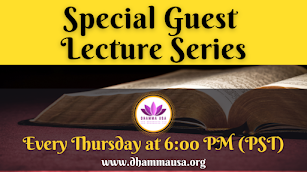Buddhist Monks as Guardians of the Environment: The Role of Spiritual Leaders in Ecological Conservation
By Nivitigala Sumitta (Bhante Sumitta)
Introduction
Buddhist monks have historically played a significant role in promoting environmental stewardship, drawing from their spiritual teachings and community influence to address ecological challenges. The Vanaropa Sutta, which emphasizes the merits gained from acts of environmental kindness, aligns seamlessly with the proactive measures taken by monks in countries like Thailand, Sri Lanka, and Myanmar. This essay explores the multifaceted contributions of Buddhist monks to environmental protection, particularly in the context of deforestation and sustainable practices.
The Ethical Framework: Insights from the Vanaropa Sutta
The Vanaropa Sutta highlights the spiritual merits associated with actions that benefit the environment, such as planting groves and providing resources for the community. These teachings encourage monks and laypeople alike to perceive their relationship with nature as a sacred duty. By framing environmental conservation as an act of merit-making, the Sutta instills a sense of responsibility towards the natural world, urging individuals to engage in practices that promote ecological balance.
In the context of deforestation, which has seen alarming rates in places like Sri Lanka—where forest cover has dropped from 49% in the 1920s to about 29.7% by 2017—these teachings become particularly relevant. The ethical guidelines outlined in the Sutta serve as a foundation for monks who advocate for sustainable practices, reinforcing the idea that caring for the environment is both a moral obligation and a path to spiritual fulfillment.
Thai Monks on the Frontlines of Environmentalism
In Thailand, a growing movement of monks is actively engaged in environmental conservation efforts, adopting innovative strategies to combat deforestation. For instance, some monks bless trees to signify their protection, a practice intended to foster community awareness about the importance of preserving nature. As Sue Darlington, a scholar of Buddhist practices, notes, these acts help people reconnect with their environment and recognize their responsibility towards it.
Thai monks also educate farmers on sustainable agricultural practices, encouraging a shift away from harmful cash cropping that leads to debt and ecological damage. For example, ecology monks experiment with alternative farming methods, sharing their findings with local communities to promote sustainability. This direct engagement highlights the monks' role not only as spiritual leaders but also as advocates for ecological integrity.
Community Engagement and Social Cohesion
The influence of monks within their communities provides a unique platform for promoting environmental awareness and action. In a society where over 90% of the population practices Buddhism, the spiritual authority of monks can effectively mobilize community members towards conservation efforts. As Vijo Varghese, co-founder of a Thai nature conservation project, emphasizes, having spiritual leaders involved in environmental issues creates a crucial link in addressing the ecological crisis.
Monks also foster social cohesion through their work. By partnering with NGOs and local organizations, they can amplify their impact and reach broader audiences. Initiatives such as creating fire breaks during the annual forest fire season demonstrate how monks actively participate in protecting local ecosystems while educating communities about environmental risks.
The Risks and Challenges of Environmental Advocacy
Despite their influential role, monks engaged in environmental protection often face significant challenges. Advocacy work can attract opposition from corporations and political entities that benefit from unsustainable practices. The tragic fate of ecology monk Phrakhu Supoj Suvacano, who was murdered for his conservation efforts, underscores the risks involved in this critical work. Monks must navigate these challenges carefully while remaining committed to their mission of safeguarding the environment.
Conclusion
Buddhist monks embody a powerful force for environmental protection, integrating spiritual teachings with proactive conservation efforts. The Vanaropa Sutta provides an ethical framework that encourages acts of kindness towards nature, while contemporary monks in Thailand and other Buddhist-majority countries actively engage in initiatives to combat deforestation and promote sustainable practices. As guardians of the environment, these monks not only fulfill a spiritual mandate but also inspire communities to recognize their interconnectedness with nature. Their work highlights the potential for spirituality to serve as a catalyst for ecological awareness and action, paving the way for a more sustainable future.
References
Darlington, S. (Year). The Ordination of a Tree. State University of New York Press; Illustrated edition (1 Feb. 2013)
Sri Lanka Forest Department. (2017). Forest Cover Report.
Samyutta Nikaya. (Year). Pali Text Society.
United Nations. (2015). Sustainable Development Goals.
The Buddhist monks blessing trees to prevent deforestation
www.devex.com/news/the-buddhist-monks-blessing-trees-to-prevent-deforestation-103705




































